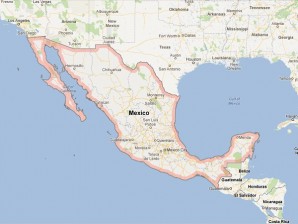
Criminal groups hold sway in 60 percent of prisons, where they are able to continue rackets in the outside world, conduct other business inside and buy off officials, according to the National Human Rights Commission (CNDH).
“The deterioration of prisons in the last few years is undeniable, as demonstrated by the escapes, fights, self-governing and assaults on prison personnel,” said Raul Plascencia, head of the governmental commission.
The CNDH issued a damning report on the state of prisons in the country some two months before President Felipe Calderon, who launched a major offensive against drug cartels in 2006, leaves office.
In the last two years alone, 14 prison escapes took place, allowing 521 prisoners to run free. Over the same period, 352 homicides were committed within prison walls.
Prisoners run black markets from their jail cells, offering protection to other inmates, selling food and mobile phones, and even bringing in prostitutes.
The CNDH visited 100 of the country’s 419 penitentiaries. The prisons its investigators inspected were the most crowded in the country, holding 75 percent of Mexico’s prison population.
In some cases, commission members were unable to visit the prison. This was the case in Piedras Negras, the prison near the US border from which 131 inmates escaped last week. Sixteen guards were detained over suspicions that the prisoners were able to walk out the front door.
The CNDH was not able to visit Piedras Negras because the prison’s officials warned that “it was impossible to guarantee the security of commission personnel,” CNDH member Guillermo Aguirre Aguilar told Milenio television.
“And when we entered some of the prisons, we weren’t able to visit and examine their entirety because we were told that the prisoners had the keys to the cells,” he said.
“We spend millions and millions to combat crime, catch criminals and put them in jail, and once they’re in there we forget about them. We put then in a position to repeat offenses once they’re free,” Aguirre added.
After the Piedras Negras escape, Calderon denounced the “vulnerability” of state prisons, noting that almost 1,000 inmates escaped from them over his six-year term but none from federal penitentiaries.
“Calderon’s statement is a fallacy, a lie disguised as truth, because the majority of escapees were convicted on federal charges,” said Pedro Arellano, a priest and director of the Catholic Church’s prison pastoral care.
“They launched a war without preparing the prisons for organized crime,” he said.
There are only 13 federal prisons in Mexico, and almost 70 percent of federal convicts— the most dangerous criminals—are jailed in regional prisons, Interior Minister Alejandro Poire said in February.
Arellano said corruption is rampant in state prisons.
“Some wardens allow prisoners to get out to carry out crimes, return to the prison and share the money,” he said.
In Piedras Negras, prosecutors suspect the Zetas drug cartel orchestrated the escape to replenish their ranks.
“Criminal organizations have taken over the penitentiary system, and use it as a springboard and an engine to fuel organized crime,” said Edgardo Buscaglia, senior research scholar at New York’s Columbia University.
Arellano agrees. “Mexican prisons have become the main recruiting center for organized crime,” he said. “Prisons are crime schools.”